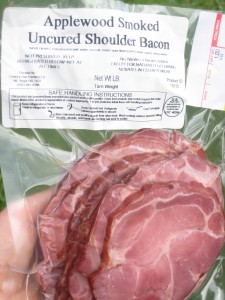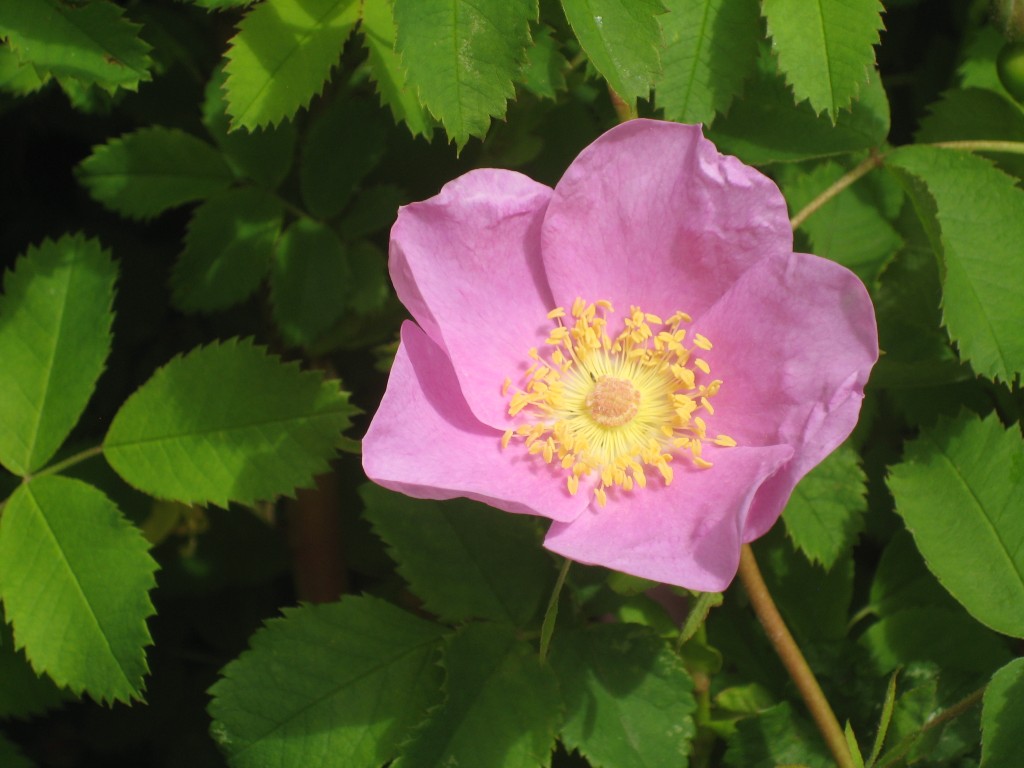As the kids and I were riding bikes this week, I was struck by the sight of a few blooming rose bushes amidst so many willows and blackberries. Although the blackberries were definitely not planted by us, the willows were — back in early 2010, when two other prior attempts to plant a hedge had seemingly failed. The first attempt happened in 2007, when Casey and I cut dormant twigs from native plants we liked and stuck them in a line along our road. Without water or tending (plus a few aggressive mows by the county), that first hedge hardly grew at all. Except for these handful of rose bushes that apparently quietly stuck around and then made a home amidst the new hedge.
And, now they are blooming: bright pink blossoms greeting us as we make our way. Although the rose bushes are now taller than me, given their location on the roadside, I doubt anyone in a car or truck would even notice them. But at the speed of foot and bike travel, they make for a breathtaking sight — so many pink buds, offering a delicious fragrance if you do indeed take time to stop. I’m smitten.
But, the whole world is offering us such gifts right now. May is such a drop dead gorgeous month. As the rain returned this week, it brought with it cleaner air again and lovely light. As the clouds come and go, shafts of sunlight make the green pastures glow with the most vibrant color of the year. That spring green just screams “life!”
And flowers abound in more places than just the hedge, of course. Flower gardens are in full glory — the kids and I visit my mother’s garden regularly to see what new delights are arriving. The snowball has passed its peak and left white blossoms all over the ground (blown by the spring winds everywhere), but the poppies are in full glory, and just in the last few days all the tame cultivated roses are opening. Some of them (the tea varieties) are much more chaste than the hedge roses, but others offer us a more voluptuous blossom to lower our noses into. Oh, this season!
Oh, and that rain? Aside from the beauty and the air cleaning, I should mention that it was also very welcome for its watering properties as well. If you haven’t driven out in the county lately, Yamhill County farmers are already in full irrigation mode. Coming on to the island last Friday evening, we counted five reel guns just by looking one direction. So, the rain was welcome. We need it. The season is so far progressed that rain does not mean we can take much of a break from irrigating, but it sure gives us some peace and a nice boost to all the plants (and pastures especially!).
We hope you have been enjoying this beautiful May and its gifts of flowers and green. Enjoy this week’s vegetables!
Your farmers, Katie & Casey Kulla
~ ~ ~
Reminder! CSA payments due by May 21! I sent out emailed statements and payment reminders to everyone who owes their next CSA installment. If you have any questions about your account or payment amount, please let me know! Otherwise you can bring us cash or check to pick-up or mail it to us: Oakhill Organics, P.O. Box 1698, McMinnville, OR 97128. Thank you!
~ ~ ~
Meet this week’s vegetables:
- Strawberries — To Casey, the arrival of strawberry and fava bean season marks the true beginning of “the growing season” (as opposed to the shoulder seasons). Weather vagaries and such still abound through the whole summer, but abundance is here and we’ve begun that awesome parade through the main season crops. Need it be said? These strawberries are the earliest we’ve ever picked (you’ll likely hear that refrain a lot from us this year). We do very little to encourage earliness in this crop — no plastic mulch or greenhouses. So, seeing red fruit in early to mid-May is surprising to us! Nonetheless, we are glad to welcome these gems, as we had just last month run out of our stored apples and the gap in fresh fruit felt rough on our farm family. But now we are rejoicing in strawberry goodness. And, friends, not only are these strawberries — they are Hoods. Which if you are from Oregon you know means flavor-packed! The flavor should only get better over the next few weeks too as temperatures go back up.
- Fava beans — Are you new to fava beans? Welcome to this new eating experience. I had certainly never eaten a fava bean until we grew them for our farm, but years later we’re totally hooked. Also known as broad beans, fava beans are a legume native to the “old” world and with a long history of cultivation. They can be used in many different culinary applications. As they get older and more mature, the tender bright green beans inside grow a slightly tougher white skin (inside the pod) that is often removed before cooking, making it a two-step process. It’s a bit laborious, but worth it a few times every spring (and good work for little hands!). I’ll write more about that in later weeks when the beans have reached that stage, but for now I’ll invite you to enjoy fava beans in a different way. At this stage, the beans inside are still quite tender and fresh, and we have learned to enjoy eating the whole bean, pod and all. You definitely need to cook these — they are only distantly related to snap beans after all. Our favorite way to cook whole fava bean pods is to roast them on a pan in the oven. This is a time when you definitely do not want to overburden the pan so as to miss out on the roasting magic (too many beans and you’ll end up steaming rather than roasting). First toss the beans in oil and then lay them on a pan and liberally salt. Roast at 425° until turning brown and getting crispy/soft. Serve whole! You can also BBQ for similar results.
- Fennel bulbs — Remember that I posted about fennel bulbs in this prior newsletter.
- Lettuce
- Mustard greens
- Kale
- Chard
- Potatoes
- Leeks — The leeks are beginning to bolt (put out seed heads). You’ll be able to see the bolts coming out of the tops of some of the leeks. That top part is super delicious — chop it up and throw it in the pan with the rest of your leeks (and remember that we even like the greens finely chopped too!). But I find that sometimes as it goes down into the leek, the bolt can become fibrous (this varies a lot from leek to leek). To check my leeks, I slice them in half and then pull out the bolt and check it separate with my knife. If it slices just beautifully, I put it in the food. If not, I’ll just put in the compost and chop up the rest of the leek. I must say, I love seeing so many vegetables harvested at different stages of their life cycle (such as eating young fava beans and then more mature beans later). Since leeks are “biennial” plants, they flower and develop seeds after a winter of being in the ground. We’re now in that part of their life! But next year’s leeks are already in the ground too (including some we’ve planted specifically for late summer harvest). This is a crop that overlaps on our farm — we always have leeks growing somewhere!
- Green garlic
- Garlic
And this week’s extra goodies from the farm: Remember to bring containers when appropriate! Especially for eggs!
- Corn flour — $5 lb
- Walnuts — $5 lb
- Green garlic & chard stalk pickles — Did you know that in some European culinary traditions, chard is actually cultivated for its stalk? I’ve heard that in some places, the greens are actually tossed to the animals as cooks focus their attention on the stalk (for uses such as delicious gratins). And yet in the U.S. so often we make the opposite mistake and put our attention on the leafy bit with some disregard for the stalk! The stalk is indeed a delicious vegetable, with the greens or on its own. This time of year as the chard also begins to “bolt” (see my comments about leeks above), those chard stalks grow extra thick and meaty. A deliciously cooked chard stalk reminds Casey and me of cardoons (another European specialty). For this week’s fermented offering, Casey chopped up chard stalks and mixed them with green garlic. We think this is going to be awesome. $8/pint, $5/half pint ($1 more for our jars)
- Eggs — $4 dozen
- Lamb — We’ve got more lamb! Prices vary depending on the cuts. The chops go fast, so if you want them, get them this week! We also have roasts of all kinds and ground lamb available as well.
 BACON! — Oh, yes! We sent hogs to the butcher a few weeks ago with directions to ‘make us some bacon’ (among other things like ham and sausage as well). Some of those tasty products are still in progress (smoking and such does take time), but today Jasper went and picked up the first installment: Canadian-style slab bacon from three different cuts (shoulder, loin, etc). This is technically “uncured” pork, meaning that it was “cured” using celery seed rather than nitrates. The result is delicious goodness. $12/lb
BACON! — Oh, yes! We sent hogs to the butcher a few weeks ago with directions to ‘make us some bacon’ (among other things like ham and sausage as well). Some of those tasty products are still in progress (smoking and such does take time), but today Jasper went and picked up the first installment: Canadian-style slab bacon from three different cuts (shoulder, loin, etc). This is technically “uncured” pork, meaning that it was “cured” using celery seed rather than nitrates. The result is delicious goodness. $12/lb- Fresh pork roasts & belly — $8 lb. These are cuts that haven’t been cured at all, so “fresh.” We have lots and lots of roasts that make for delicious crock pot meat. Pulled pork anyone? Yes, please!
- Pork fat & skin — $3 lb
- Ground beef — It’s back!!!!! $7 for 1/lb packages. “And, there was much rejoicing.”




Pingback: Feeding our family of four | Oakhill Organics